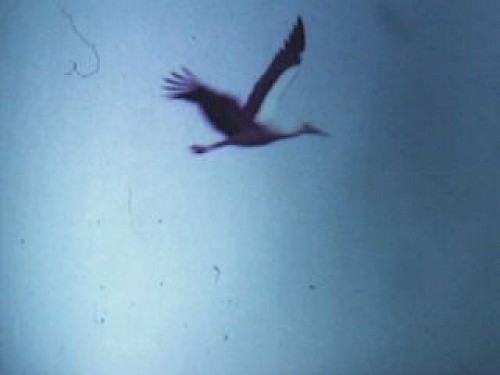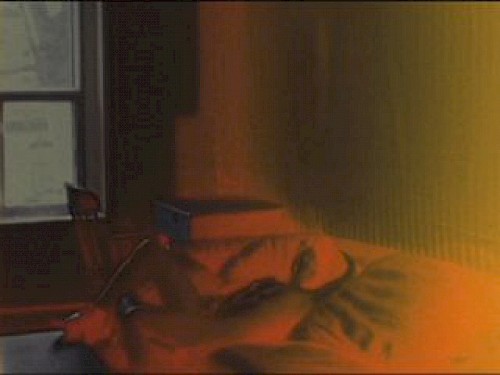If the quest for identity is the leitmotiv of these artists, the idea of bad genius evokes the subversive character of the images and the comments made in relation to the (heteronormed) codes of the cinematograph. The films presented celebrate the encounter with the other, another with whom to (re)discover one’s feminine or queer identity, which is essentially plural.
Between 1981 and 1997, Anne Charlotte Robertson made a huge filmed diary of more than thirty hours. The scrolling of her life is superimposed on the scrolling of images that bear witness to an existence haunted by mental illness. Reel 40 dates from 1984. In this chapter, the filmmaker returns to the places where her mother lived. In the image: rooms of a house, photos and tombstones follow one another. In sound: existential questions, melancholic reflections interspersed with celebrations of the Cosmos. The stars like the setting sun or a crescent moon punctuate the film in an almost meditative way. The luminous manifestations are treated as religious experiences. This particular attention to the play of light is often reinforced by time-lapse effects that accentuate their sacred dimension. Thus, the light from a window is similar to a divine presence. The artist films a stained glass window representing the Paschal Lamb, symbol of mercy, and presents herself as a new Mary Magdalene.
To escape her family memories and this mystical delirium, Robertson takes to the road leaving behind the city lights and other advertising signs. The latter switch from sharp to blurred and from figurative to abstract according to the speed of her nocturnal race. Their distressing, electrifying and chaotic aspect refers to her deleterious state such as mood swings or sudden attacks of anxiety. The journey by car becomes thus an outlet for his spleen. The protective cabin allows him to contemplate the world and to scrutinize the places through his camera. An almost animistic road movie follows when she finally reaches the sublime landscapes of Wyoming. Wide open spaces, cows, sheep and bison come to heal her sadness. A communion with Nature, even the hope of a fusion with it, seems to be hoped for.
Reel 23 was shot seven years later. The artist, affected by a love affair, has locked herself up in her apartment. In front of the camera, the young woman confesses: she talks about her illness, her complex relationship with food and her desire to merge with the world. For her, everything makes sense: a TV movie and she invents a role for herself, an exchange of views and it’s true love… Reality falls into fiction and it is the crisis. Her convulsive state is accompanied by an elastic relationship to time (violent variations in the rhythm of the images, stop motion) and an obsession with details that grows. Insistent close-ups, even macro shots of the meals she prepares for herself and abandons as they are, attest to the dislocation of her world. The film is an uncompromising self-portrait. The filmmaker analyzes herself. Comments, as if taken on the spot, attest to this day-to-day struggle against depression. The tone oscillates between black humor and bottomless anguish. In her ramblings, she claims to be a vegan, investigates God or notes tongue-in-cheek that the only difference between TV shows and her DIY short films is that the latter are without credits. We witness the singular preparations for filming with various foods, including cat food… A poetics of objects at the limit of the abject and which also makes think of an alchemical practice or of witchcraft rituals. However, filming herself allows her to distance herself from her psychological fragility, to try to curb the difficulties encountered in structuring daily life, to compensate for a feeling of irreversible fragmentation of herself and the world, to try not to confuse her internal self with the external. The film documents the progression of his illness and the vain attempts to channel his relationship to the world. Her logorrhea continues by evoking the death of her relatives who come back to haunt her: mother, father, brother…
Maplo’sMy trip To Klonowa is a work of found footage that uses a single shot of a bird flying. Through editing, it is multiplied to evoke, despite the repetitions, a long itinerary. The movements of the bird are (un)composed and (re)composed (to the point of anamorphosis) before our eyes. The diffraction of the shots induced by the multiplication of the screens reinforces the pugnacity of the bird which pursues its race strewn with audiovisual hazards. The film sings of a return to one’s origins, and more particularly to the Polish city mentioned in the title of the short film, where the artist’s family is native.
Leaven mixes visual superimpositions and impressionistic narrative. Maplo addresses the sphere of the intimate as well as a discourse on the image as such. The deliberate use of worn-out chemistries brings together realistic images and solarized or glowing silhouettes in the same shot. The semi-autobiographical film evokes the departure of her lover haunted by invasive visions that incite the narrator to a journey towards (mis)known lands: that of the cinematographically fantasized “vision” of the beloved woman that comes to contaminate her memories. An interior voyage follows via a literal apology of solitary pleasures (onanism referring to the manual development and physical alterations of the silver emulsion).
Pioneer of queer and feminist cinema, Barbara Hammer directed Dyketactics in 1974. In the undergrowth, women dance like nymphs finally freed from the grip of fauns and other male demons. Sorority and sensuality go hand in hand. Then we witness the embrace of a couple. Paced by a hypnotic music and by superimpositions presenting embracing bodies, carnal pleasure occupies a central place. The film replaces the bodies (skin comes from the word pellis, which gave the word film) to become a support for the sexual and identity claims of the filmmaker.
The last film of the session, Superdyke, made in 1976, again proposes a feminizing re-reading of archetypes. Brandishing “Amazon” shields, t-shirts proclaiming “Superdyke” and fake colonial helmets hijacked by satyric slogans, a group of lesbians turn their daily lives into a feminist struggle. However, the term “struggle” should not be understood in a violent dimension, but rather that of an obviousness, of a state of affairs that asserts itself and joyfully shakes up the public space. Despite the inconveniences of everyday life such as bad weather or a broken leg, dancing, laughter and hugs are the order of the day. We mime Diane archers, helmeted or crowned with laurels, making fun of the spirit of the mythological hunt. The connivance and the play infuse a serious subject with a good-natured spirit. On board the “Lesbian Express”, Hammer presents the collective as a liberating force without excluding the humor and joy of life that accompany it. After the Beatles’ “Magical Mystery tour”: “Roll up to the Lesbian Express”!
—
Gabrielle Reiner and Thibaud Leplat




















